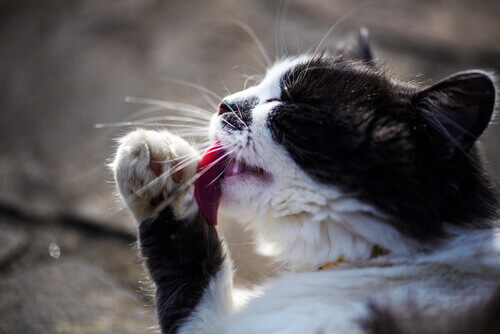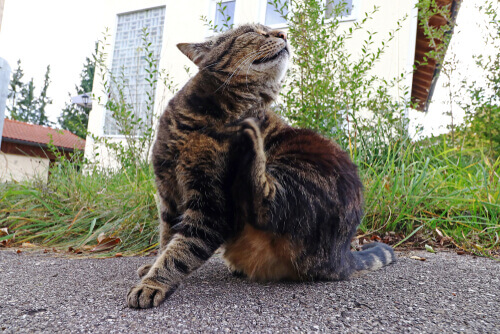Alopecia in Cats


Written and verified by the lawyer Francisco María García
Cats take care of their fur and keep it clean and shiny, which is a sign of good health. However, excessive hair loss or alopecia in cats is a sign of a pathology.
The causes of feline alopecia are varied. A vet will need to examine the animal and identify the exact condition in order to determine the appropriate treatment.
The most frequent causes are laid out below.
Causes of alopecia in cats
Cats lose hair naturally. But, when this loss is excessive and leaves visible areas of colored skin that may be inflamed or have spots, it means there’s an underlying problem.
Fleas and mites
Cats are allergic to flea and mite bites, so they scratch the area and pull out the fur. This causes alopecia, especially in areas such as the back and tail. The bite can even cause an infection in the skin that will look reddish and scaly.
The mites burrow under the cat’s skin, resulting in mange. The itching is so intense that the cat scratches and licks the skin to relieve itself, and this leaves hairless patches. In severe cases, it can spread over the entire body.
 Ringworm
Ringworm

Ringworm is a fungus that develops on the face, ears, head and sometimes paws of cats. In addition to alopecia, the skin may appear scaly, dry or crusty; it also causes intense itching. This condition is contagious and can spread to other pets or humans.
Allergies
These can be caused by food, such as some proteins like fish, chicken, or beef; in this case, the skin will be reddened and have bumps.
An allergy to certain chemicals, plastics, rubber or wool can also cause dermatitis and alopecia in cats. Thallium and iodine are highly toxic to felines and cause immediate hair loss.
Hormones
The endocrine system regulates hair growth in cats, so any hormonal problem can cause alopecia. This happens with the decrease of sexual hormones after castration and with the excess of them in dominant males.
When the cause of alopecia is a hormonal imbalance, the hair loss is uniform and occurs all over the animal’s body. This is easy for the owner to identify.
Cushing’s disease
This is a condition of the adrenal glands, which produce excessive steroid hormones. One of the symptoms in cats is alopecia, with hair falling out symmetrically all over the body.
Psychological issues
Cats are very sensitive animals and prone to stress from drastic changes and other psychological factors. Likewise, confinement and boredom can cause cats to groom excessively, resulting in hair loss.
Thyroid problems
It’s possible that the cat is suffering from hypo- or hyperthyroidism. This disorder of the thyroid glands not only causes excessive hair loss, but also spots, flaky and painful skin, and fever.
 Neoplasia
Neoplasia
In this case, alopecia is accompanied by skin ulcers, which can become infected causing purulent secretions. This is one of the most serious causes of hair loss in cats, as it indicates the presence of a carcinoma.
Diagnosis and treatment of alopecia in cats
Alopecia in cats is easily identifiable by their owners, who will find tufts of feline hair everywhere. In addition, the cat will have areas of bare skin which will irritate them and make them lick and nibble at the affected skin.
The vet will do a thorough examination of the cat in order to determine the specific cause of its alopecia. If necessary, they’ll take hair, skin, blood or urine samples to help with the diagnosis.
Treatment will depend on the cause of alopecia. Some of the underlying conditions are easy to treat, such as fleas or ringworm; other causes can lead to serious health problems that put the cat’s life at risk. This is why it’s important to consult a professional at the first sign of alopecia and to avoid home treatments.
It’s also important to remember that some preventive measures can be of great help when it comes to taking care of your cat’s health at home. It’s vital to keep the environment free of fleas, ticks and mites, and even more so if you have several pets.
Other good habits include giving your cat food that’s appropriate for its age, in order to keep its coat healthy. As far as possible, avoid situations that will cause stress for your cat.
Cats take care of their fur and keep it clean and shiny, which is a sign of good health. However, excessive hair loss or alopecia in cats is a sign of a pathology.
The causes of feline alopecia are varied. A vet will need to examine the animal and identify the exact condition in order to determine the appropriate treatment.
The most frequent causes are laid out below.
Causes of alopecia in cats
Cats lose hair naturally. But, when this loss is excessive and leaves visible areas of colored skin that may be inflamed or have spots, it means there’s an underlying problem.
Fleas and mites
Cats are allergic to flea and mite bites, so they scratch the area and pull out the fur. This causes alopecia, especially in areas such as the back and tail. The bite can even cause an infection in the skin that will look reddish and scaly.
The mites burrow under the cat’s skin, resulting in mange. The itching is so intense that the cat scratches and licks the skin to relieve itself, and this leaves hairless patches. In severe cases, it can spread over the entire body.
 Ringworm
Ringworm

Ringworm is a fungus that develops on the face, ears, head and sometimes paws of cats. In addition to alopecia, the skin may appear scaly, dry or crusty; it also causes intense itching. This condition is contagious and can spread to other pets or humans.
Allergies
These can be caused by food, such as some proteins like fish, chicken, or beef; in this case, the skin will be reddened and have bumps.
An allergy to certain chemicals, plastics, rubber or wool can also cause dermatitis and alopecia in cats. Thallium and iodine are highly toxic to felines and cause immediate hair loss.
Hormones
The endocrine system regulates hair growth in cats, so any hormonal problem can cause alopecia. This happens with the decrease of sexual hormones after castration and with the excess of them in dominant males.
When the cause of alopecia is a hormonal imbalance, the hair loss is uniform and occurs all over the animal’s body. This is easy for the owner to identify.
Cushing’s disease
This is a condition of the adrenal glands, which produce excessive steroid hormones. One of the symptoms in cats is alopecia, with hair falling out symmetrically all over the body.
Psychological issues
Cats are very sensitive animals and prone to stress from drastic changes and other psychological factors. Likewise, confinement and boredom can cause cats to groom excessively, resulting in hair loss.
Thyroid problems
It’s possible that the cat is suffering from hypo- or hyperthyroidism. This disorder of the thyroid glands not only causes excessive hair loss, but also spots, flaky and painful skin, and fever.
 Neoplasia
Neoplasia
In this case, alopecia is accompanied by skin ulcers, which can become infected causing purulent secretions. This is one of the most serious causes of hair loss in cats, as it indicates the presence of a carcinoma.
Diagnosis and treatment of alopecia in cats
Alopecia in cats is easily identifiable by their owners, who will find tufts of feline hair everywhere. In addition, the cat will have areas of bare skin which will irritate them and make them lick and nibble at the affected skin.
The vet will do a thorough examination of the cat in order to determine the specific cause of its alopecia. If necessary, they’ll take hair, skin, blood or urine samples to help with the diagnosis.
Treatment will depend on the cause of alopecia. Some of the underlying conditions are easy to treat, such as fleas or ringworm; other causes can lead to serious health problems that put the cat’s life at risk. This is why it’s important to consult a professional at the first sign of alopecia and to avoid home treatments.
It’s also important to remember that some preventive measures can be of great help when it comes to taking care of your cat’s health at home. It’s vital to keep the environment free of fleas, ticks and mites, and even more so if you have several pets.
Other good habits include giving your cat food that’s appropriate for its age, in order to keep its coat healthy. As far as possible, avoid situations that will cause stress for your cat.
This text is provided for informational purposes only and does not replace consultation with a professional. If in doubt, consult your specialist.








